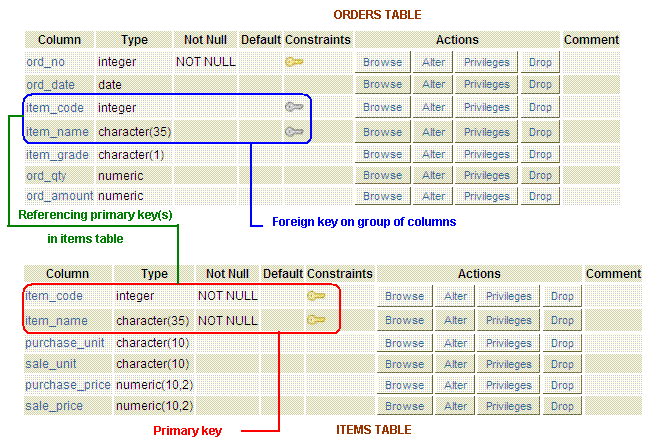
- #GETORGCHART AJAX FOREIGN KEY HOW TO#
- #GETORGCHART AJAX FOREIGN KEY UPDATE#
- #GETORGCHART AJAX FOREIGN KEY MANUAL#
- #GETORGCHART AJAX FOREIGN KEY CODE#
But you will effectively be rewriting Sybase/MS C (or whatever it is) code, using T-SQL. You can precisely replicate the functionality of a FK constraint using a trigger. In such cases, using integrity constraints eliminates the performance overhead incurred by this transmission. Since your applications use SQL, they cannot achieve this level of optimization.Įnforcing business rules with SQL statements can be even more costly in a networked environment because the SQL statements must be transmitted over a network. The semantics of integrity constraints are very clearly defined, so the internal operations that Oracle performs to enforce them are optimized beneath the level of SQL statements in Oracle. I don't know about you but it makes perfect sense to me.Įnforcing rules with integrity constraints is less costly than enforcing the equivalent rules by issuing SQL statements in your application. Here's another reference to Oracle8 for enforcing business rules to your DB through integrity constraints (foreign keys). Sorry, I don't agree with using triggers in place of foreign keys.
#GETORGCHART AJAX FOREIGN KEY UPDATE#
For example, creating an AFTER UPDATE statement trigger on the EMP table that itself issues an UPDATE statement on EMP causes the trigger to fire recursively until it has run out of memory. * Be careful not to create recursive triggers.
#GETORGCHART AJAX FOREIGN KEY CODE#
If the logic for your trigger requires much more than 60 lines of PL/SQL code, it is better to include most of the code in a stored procedure, and call the procedure from the trigger. * Limit the size of triggers (60 lines or fewer is a good guideline). For example, do not define triggers to enforce data integrity rules that can be easily enforced using declarative integrity constraints. * Do not define triggers that duplicate the functionality already built into Oracle. * Use database triggers only for centralized, global operations that should be fired for the triggering statement, regardless of which user or database application issues the statement. * Use triggers to guarantee that when a specific operation is performed, related actions are performed. Use the following guidelines when designing triggers: Whatever happened to those ERDs (for Frank, Entity Relationship Diagrams) and UML (Universal Modeling Language) Class Diagrams? Do they just get thrown out the window in the physical DB Design phase? Here's a direct quote from the Oracle8 Server Application Developer's Guide Second: If there is NO merit to what he says, can anyone suggest some simple demos to illustrate that fact to him?įoreign Keys = True Referential Integrity

#GETORGCHART AJAX FOREIGN KEY HOW TO#
Foreign-keys are fundamental to all relational DB systems, not just MSSQL - why have them if they are inferior? So, I need to either find out he's right (unlikely), or find out how to present to him the facts so that he doesn't go making insane redesigns to our current system.įirst: Is there any merit to what he says? Can straight-forward FKs cause timeouts? How significant is the timeout risk? How best to mitigate this issue? If foreign-keys were inferior to triggers, imagine there would be an immense number of articles on sources like trumpeting that fact. He says that building triggers in all the places where referencial data integrity is needed is the best solution. I have a new collegue who insists that foreign-keys are evil, and are a major source of deadlocks. This is where the real magic happens, in official document, the JavaScript code only add headers to the request: document.(This may have been asked before, and if so, please just point me to the right place.) Public IActionResult Delete(Guid pingbackId) This has no different than a normal action method. And if some day I changed the name in antiforgery options, I don't need to worry about forget to change it everywhere in my cshtml pages. So basically, will generate HTML based on my definition in Startup.cs like this.
#GETORGCHART AJAX FOREIGN KEY MANUAL#
And I don't want to forget to change every place where there is a manual written input tag. The backend Controller will use these names to validate the request.

But most importantly, because I have defined customized names for the CSRF tokens like this: services.AddAntiforgery(options => First, of course it can save few lines of code.

Return Xsrf.GetAndStoreTokens(Context).RequestToken In my practice, there's difference between official document and my scenarios.įirst, we still need a hidden input to store the CSRF token, instead of this code in official document: string GetAntiXsrfRequestToken() Please do read the official document first:

The official document didn't document how to do it via jQuery. In ASP.NET Core, if we use jQuery Ajax to post data to the server, and we want the ValidateAntiForgeryToken attribute to work. Original Edi Wang Wednesday, September 19, 2018


 0 kommentar(er)
0 kommentar(er)
